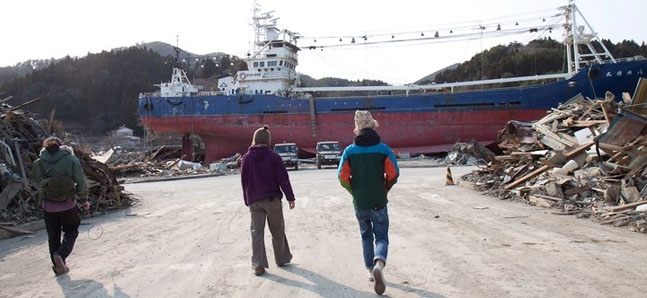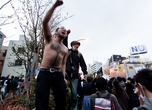
Posted: Thu Apr 14 2011
If I had to describe what I saw in a single word, I'd say it was a battlefield. A mountain of rubble and burnt scrap wood. A boat carried right up to the front of the town train station. The faint, lingering smell of burning.

'If I had to describe what I saw in a single word, I'd say it was a battlefield'
There were almost no buildings left in their original form. I presumed that there were only roads because the Self-Defence Forces had cleared the rubble away to make them, and even then it was painfully clear that they were short of people to help with the work.

'It was painfully clear that they were short of people to help with the work'
The closer I got to the sea, the more the roads disappeared, and the more the mountains of debris piled up. In the end I couldn’t find any point from which I could see the ocean. The everyday items, photographs and dolls, scattered here and there, were the sole evidence that people had lived here at all. I found almost nothing that would make it possible to imagine that a town had ever existed.
I was walking around the area with Wataru Sasaki, a photographer from Kesennuma who took these pictures, and we happened across a friend of his. She had come back to Kesennuma from Tokyo to search for mementoes in the mountain of rubble that used to be her birthplace. We walked around the town for about an hour and then went to Sasaki’s parents’ house. At 8pm, just as we were preparing to head back to Tokyo, it started to snow. We got back to Tokyo at 2am.
A week has passed since then and the situation, and the supplies that are needed, may have changed. Petrol is more easily available, even in the disaster-stricken areas, and the roads are returning to normal. The conditions are such that day-trips are possible, so I think people should take supplies that are needed, visit the actual places and see for themselves the present state of things. There is still so much that we can do.

Image of hope: This board lists the names of people who have been found safe
Postscript
Following my visit, I received an email of thanks from Shinpei Karazawa, the executive director of Nihon no Mori Biomass Network, along with the following message. I’ve reproduced it in the hope that the circle of support will continue to grow.
'I’d like to thank you for taking the trouble to travel all the way from Tokyo. For the victims, what is most uplifting isn't the actual supplies themselves, but the fact that so many people are supporting them.
'I think that the people in the shelters were able to appreciate the feelings of everyone at Give Me Vegetable, and of those who provided the vegetables, by actually seeing your faces and being able to talk with you. When life has settled down a bit more I think they would also really appreciate a live music event too.
'We have also received donations from people who have seen the work that your group has been doing. I’ve truly felt the warm circle of support that has been spreading from person to person and continues to grow.
'I look forward to our continued acquaintance.'
Click here to return to the first page
Tweets
- About Us |
- Work for Time Out |
- Send us info |
- Advertising |
- Mobile edition |
- Terms & Conditions |
- Privacy policy |
- Contact Us
Copyright © 2014 Time Out Tokyo

















Add your comment